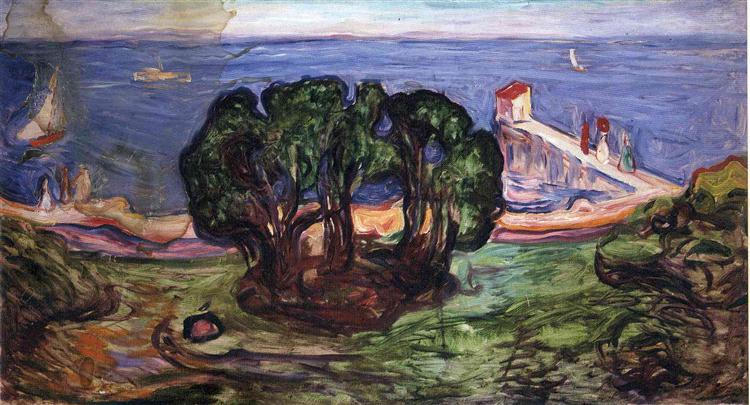Description
The painting "trees on the shore", created in 1904 by Edvard Munch, is a work that encapsulates the essence of an artistic period in which symbolism was in its peak. Munch, known for her exploration of the human psyche and feelings through art, uses in this work a visual language that, although apparently simple in the representation of a landscape, evokes a deep sensation of loneliness and melancholy.
When observing the painting, a composition is described that, at first glance, seems to be a natural landscape. In it, a group of high trees positions itself on the edge of a body of water, silhoueting itself against a sky loaded with clouds that suggests an imminent climate. This use of the natural environment is not fortuitous, since Munch manages to make him a means to express his own psyche and the predominant emotional state. The trees, robust and almost anthropomorphic, seem to reflect the introspection of the artist, becoming guard figures that monitor a space stripped of human presence.
The treatment of color in "trees on the shore" is remarkable. Munch uses a reduced palette, dominated by dark green and blue tones, which provide a gloomy and melancholic atmosphere. The transition of colors in the sky, which goes from a deep blue to an almost opaque gray, possibly symbolizes a gloomy mood or existential anguish that tormented the artist in his years of creation. This interaction between heaven, water and trees generates a sensation of cohesion, but also of tension; A silent dialogue that tells us about the dual nature of the human being, strong and vulnerable at the same time.
In this work we do not find visible characters, which could suggest an intention of Munch of provoking an introspective reflection in the viewer. The absence of the human figure is significant in the context of symbolism, where Munch found in solitude a recurring theme. In this way, painting becomes a mirror of the human being that, although surrounded by its environment, faces its loneliness and search for meaning in life.
Edvard Munch, a pioneer of expressionism, uses elements of his personal life and experiences to extract universal emotions in his works. "Trees on the shore" can be seen as part of a broader body that deals with similar themes of nature, loneliness and existential anguish, a line that can also be found in other works such as "The cry" and "Madonna " Munch presents landscapes that transcend the merely visual to enter an emotional field, taking the viewer to a kingdom where nature becomes a reflection of the soul.
The work, although less known than others, contributes to the rich variety of symbolism in the art of the early twentieth century. In it, Munch not only documes a landscape, but also invites us to travel the edge of our own emotions, where each tree can be a metaphor of the personal moments and struggles that each of us faces. Thus, "trees on the shore" remains a legacy of Munch's genius, a reminder that art has the power to communicate the ineffable and connect our deepest and more solitary experiences with the natural world that surrounds us.
KUADROS ©, a famous paint on your wall.
Hand-made oil painting reproductions, with the quality of professional artists and the distinctive seal of KUADROS ©.
Art reproduction service with satisfaction guarantee. If you are not completely satisfied with the replica of your painting, we refund your money 100%.

